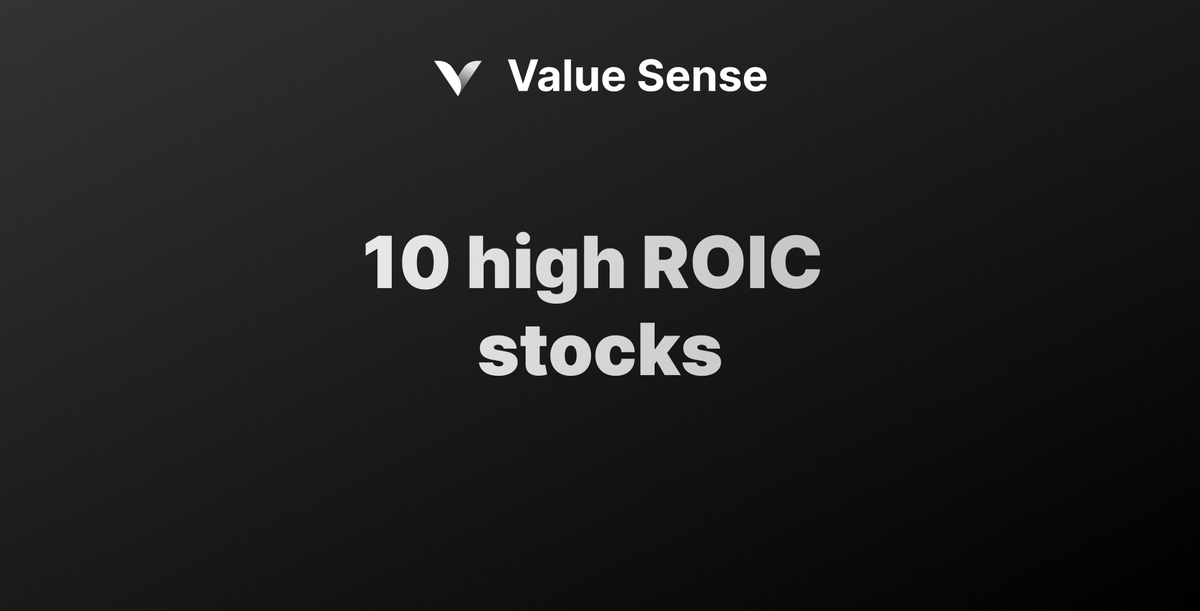10 high ROIC stocks

Here’s the new list of Value Sense’s top high ROIC picks to buy for the third quarter of 2024.
Return on Invested Capital (ROIC) is a key financial metric that measures how efficiently a company uses its capital to generate profits. ROIC is calculated as:
ROIC = Net Operating Profit After Taxes (NOPAT) / Invested Capital
- NOPAT represents the company's core operating profits after taxes
- Invested Capital includes both equity and debt used to fund the business operations
10 High ROIC Stocks to Buy for Q3 2024
Microsoft Corporation (MSFT)
ROIC - 30.2%
Industry median: 3.3%
Taiwan Semiconductor Manufacturing (TSM)
ROIC - 19.1%
Industry median: (1.1%)
Eli Lilly and Company (LLY)
ROIC - 26.2%
Industry median: (39.5%)
Broadcom (AVGO)
ROIC - 24.1%
Industry median: (1.1%)
Oracle (ORCL)
ROIC - 15.2%
Industry median: 3.3%
The Procter & Gamble (PG)
ROIC - 19.5%
Industry median: 10.4%
Home Depot (HD)
ROIC - 34.7%
Industry median: 5.9%
Costco Wholesale (COST)
ROIC - 18.9%
Industry median: 5.8%
AbbVie (ABBV)
ROIC - 18.1%
Industry median: (39.5%)
QUALCOMM (QCOM)
ROIC - 21.8%
Industry median: (1.1%)
Key Points About ROIC:
- It measures how well a company generates profits relative to the capital invested in the business.
- A higher ROIC indicates the company is using its capital more efficiently to generate returns.
- It's generally considered better than metrics like ROE or ROA because it accounts for the entire capital structure.
- ROIC above the company's cost of capital indicates value creation for shareholders
How to Apply ROIC in Investing Research:
- Compare to Cost of Capital: Look for companies with ROIC consistently above their weighted average cost of capital (WACC), as this indicates value creation.
- Analyze Trends: Examine how a company's ROIC has changed over time. Consistently high or improving ROIC is a positive sign.
- Industry Comparisons: Compare a company's ROIC to industry peers to identify potential competitive advantages.
- Assess Capital Allocation: High ROIC companies tend to be more efficient at allocating capital to profitable projects.
- Valuation Context: Companies with higher ROIC often trade at higher price-to-book ratios, but may not necessarily be overvalued.
- Growth Potential: Look at incremental ROIC to assess if a company still has profitable growth opportunities.
- Competitive Moat: Consistently high ROIC relative to peers can indicate a strong competitive position or economic moat.
- Divisional Analysis: For conglomerates, try to calculate ROIC for individual business segments to identify strengths and weaknesses.
- Adjust for Intangibles: Consider adjusting invested capital for R&D and other intangibles to get a more accurate picture for certain industries.
- Combine with Other Metrics: Use ROIC alongside other financial metrics and qualitative factors for a comprehensive analysis.
